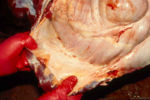Difference between revisions of "Category:Intestine - Mechanical Obstruction"
Jump to navigation
Jump to search
| Line 15: | Line 15: | ||
| − | + | ||
[[Impaction, Colonic - Horse]] | [[Impaction, Colonic - Horse]] | ||
Revision as of 12:39, 31 May 2010
- Acute of chronic mechanical obstruction of the intestine can occur in all species.
- Acute obstruction usually involves the upper or middle small intestine
- Chronic obstruction typically occurs in the distal small intestine or large intestine.
- Three main categories of causes of obstruciton:
- Intraluminal
- E.g. foreign bodies, food impaction.
- Intramural
- E.g. neoplasia
- Extrinsic
- E.g. adhesions, neoplasia and prostate enlargement.
- Intraluminal
Intraluminal Obstruction
Foreign Bodies, Intestinal
Extrinsic Obstruction
- Obstruction of the intestine due to external factors such as tumours, abscesses, and fibrous adhesions is a common occurrence.
Inflammatory Adhesions
- Arise following gut perforation, peritonitis or surgery.
- Consist of fibrous tissue bands that may:
- Restrict intestinal motility
- Cause kinks in the mesentery.
Prostatic Enlargement
- In the dog
- Can lead to compression of the rectum
Neoplasia
- Neoplasi in structures adjacent to the intestines can spread and cause external compression.
- Pancreatic tumours in particular can extend and impinge on the duodenum.
- Pedicles of tumours such as lipomas in horses can become wound in loops of intestine leading to obstruction and possible strangulation.
- Clinical
- Pathogenesis
- Seen occasionally in cat (rarer in dog)
- Usually towards end of intestines
- E.g. at the ileocaecocolic valve.
- Gut proximal to tumour becomes thickened due to hypertrophy of smooth muscle as a result of trying to force ingesta past progessively narrowing lumen.
- Produces "hose pipe intestine".
- Seen with carcinoma, lymphoma, leiomyoma and other tumours.
Pages in category "Intestine - Mechanical Obstruction"
The following 10 pages are in this category, out of 10 total.

